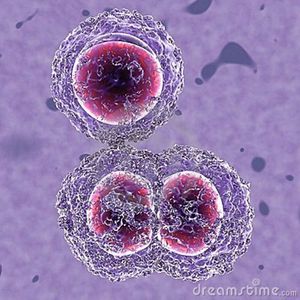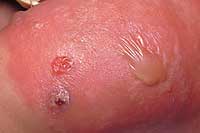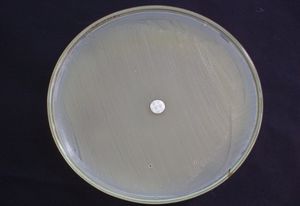User:A.guan610
Introduction

Meticillin resistant Staphylococcus aureus (MRSA) is a gram-positive cocci bacterium which has developed resistance towards not only meticillin as the name implies, but any β-lactam antibiotics. β-lactam antibiotics are a class of antibiotics which encompass the penicillin family whose effect is to inhibit peptidoglycan synthesis in bacteria. β-lactam antibiotics include penicillin and penicillin derivatives as well as carbapenems, monobactams and cephalosporins. MRSA is a growing problem – originating in hospitals around the 1960’s – as it causes serious disease such as bacteremia, pneumonia and meningitis[1]. These diseases are possibly fatal and hard to treat as antibiotic treatment becomes limited when the bacteria causing infection becomes resistant [1]. Another problem which arises with the spread of MRSA is the development of resistance to other antibiotics; currently, vancomycin is used to treat MRSA, however there have been documented cases of Vancomycin resistant strains of MRSA [2]. Patient prognosis for infection with MRSA with Vancomycin resistance is poor and often lack viable forms of treatment [3]. This poses the problem of the emergence of a MRSA strain completely resistant to all antibiotics in current use.
Mechanism of Resistance
MRSA are resistant towards β-lactam antibiotics through a variety of mechanisms [2]. Βeta-lactams normally inhibit bacterial cell wall synthesis by inhibiting peptidoglycan elongation. They can produce β-lactamases which are extracellular degradative enzymes specific to β-lactams [4]. They also encode a different penicillin binding protein (PBP) called PBP2a which can catalyze transpeptidase reactions for peptidoglycan synthesis even in the presence of β-lactams [5].

Current Treatment for MRSA
Currently, antibiotics such as Vancomycin and Linezolid are used to treat MRSA infections [6]. Although these antibiotics are usually saved for emergency situations as they are the remaining treatment for an otherwise antibiotic resistant bacterium.
Possible future treatments for MRSA
Phage treatment
The use of bacteriophages or viruses which specifically attack bacteria has been proposed by Kraushaar et at. (2013) to fight MRSA infections. He tested the effects of three virulent phages on MRSA and observed MRSA lysis in 60% of the MRSA sample [7]. Lysis in the MRSA samples demonstrates susceptibility of the bacteria to this form of treatment. The advantages of using phages are that they are highly specific for the bacteria, do not cause allergies and thus will not harm the patient. Also, they are self-replicating and self-limiting, meaning they will not stay within the patient’s body after the infection is gone. The disadvantage of this treatment is that MRSA can develop resistance to phages much like how they develop resistance to antibiotics. However, Kraushaar et al. (2013) explains that this problem can be alleviated by administering a combination of different bacteriophages specific for MRSA as resistance against all strain is highly unlikely.

Antimicrobial peptides
Lohan et al. has proposed the use of antimicrobial peptides as treatment for multidrug resistant strains of S. aureus (2013)[8]. The benefits of this type of treatment lie in its mechanisms of action. It disrupts the general cell membrane rather than interfere with a particular enzyme as traditional antibiotics function. Since it targets the general cell membrane rather than a specific target, it is much harder for the bacterium to develop resistance. Lohan et al. showed that MRSA was particularly susceptible to antimicrobials (2013)[8].
Antimicrobial peptides (AMPs) can also be used in a preventative fashion, as shown by Göblyös et al (2013)[9]. It has been shown that carriers of MRSA often have colonies within their nose. By applying a cream containing antimicrobial peptides, MRSA colonies can be effectively eliminated, greatly decreasing the risks of infections, such as pneumonia. Once again, it is difficult for bacteria to mount resistance against AMPs due to their broad-spectrum nature. For example, most AMPs are cationic and thus will interact with the negative nature of bacteria cell membranes; it would be extremely difficult to mount resistance against a peptide which binds through ionic forces.
In addition, Göblyös et al. (2013)[9] also proposes that AMPs may be able to activate a patient’s immune response through chemokine - like activities, effectively increasing the rate of bacteria removal. Chemokines are signaling molecules which are crucial to the immune response as they serve as the communication medium between different components of the immune system.
However, the disadvantage of such peptides lies in their instability and potential toxicity; in addition to adverse effects, they are also expensive agents to produce [10].
Targeting Virulence
Fitzgerald-Hughes et al. (2012) proposes a novel approach to treating MRSA with low risk of resistance development[10]. The treatment involves Antipathogenic agents which inhibit virulence. The reason MRSA have a low chance of developing resistance against these agents is because they do not kill the bacterium. They simply stop the bacterium from being virulent and other processes – such as the natural immune system – can then eliminate the infection.
In MRSA’s case, potential virulence targets have been identified by Fitzgerald-Hughes et al. (2012): Sortase enzyme system, carotenoid biosynthetic pathways and accessory gene regulator (agr)[10].
References
[1] Qiao Y, Dong F, Song W, Wang L, Yang Y, Shen X. Hospital- and community-associated methicillin-resistant Staphylococcus aureus: a 6-year surveillance study of invasive infections in Chinese children. Acta Paediatrica [serial online]. November 2013;102(11):1081-1086. Available from: Academic Search Complete, Ipswich, MA. Accessed October 31, 2013.
[2] Lowy F. Antimicrobial resistance: the example of Staphylococcus aureus. Journal Of Clinical Investigation [serial online]. May 2003;111(9):1265. Available from: Academic Search Complete, Ipswich, MA. Accessed October 29, 2013.
[3] Wang J, Lai C, Lin H, Chen W, Shih Y, Hung C. High vancomycin minimum inhibitory concentrations with heteroresistant vancomycin-intermediate Staphylococcus aureus in meticillin-resistant S. aureus bacteraemia patients. International Journal Of Antimicrobial Agents [serial online]. November 2013;42(5):390-394. Available from: Academic Search Complete, Ipswich, MA. Accessed October 31, 2013.
[4] Obajuluwa A, Udobi C, Onaolapo J, Oyi A. COMPARATIVE STUDIES OF THE ANTIBACTERIAL ACTIVITIES OF THE EXTRACTS OF PARTS OF THE AFRICAN LOCUST BEAN (PARKIA BIGLOBOSA) TREE AGAINST HYPER BETA LACTAMASE PRODUCING STAPHYLOCOCCI (PHENOTYPIC MRSA) ISOLATES FROM ORTHOPAEDIC PATIENTS. International Journal Of Pharma & Bio Sciences [serial online]. October 13, 2010;1(4):P1-P6. Available from: Academic Search Complete, Ipswich, MA. Accessed November 22, 2013.
[5] Tawil N, Mouawad F, Lévesque S, Sacher E, Mandeville R, Meunier M. The differential detection of methicillin-resistant, methicillin-susceptible and borderline oxacillin-resistant Staphylococcus aureus by surface plasmon resonance. Biosensors & Bioelectronics [serial online]. November 15, 2013;49:334-340. Available from: Academic Search Complete, Ipswich, MA. Accessed November 22, 2013.
[6] Puzniak L, Morrow L, Huang D, Barreto J. Impact of Weight on Treatment Efficacy and Safety in Complicated Skin and Skin Structure Infections and Nosocomial Pneumonia Caused by Methicillin-Resistant Staphylococcus aureus. Clinical Therapeutics [serial online]. October 2013;35(10):1557-1570. Available from: Academic Search Complete, Ipswich, MA. Accessed October 31, 2013.
[7] Kraushaar B, Thanh M, Hammerl J, Reetz J, Fetsch A, Hertwig S. Isolation and characterization of phages with lytic activity against methicillin-resistant Staphylococcus aureus strains belonging to clonal complex 398. Archives Of Virology [serial online]. November 2013;158(11):2341-2350. Available from: Academic Search Complete, Ipswich, MA. Accessed October 31, 2013.
[8] Lohan S, Cameotra S, Bisht G. Systematic Study of Non-Natural Short Cationic Lipopeptides as Novel Broad-Spectrum Antimicrobial Agents. Chemical Biology & Drug Design [serial online]. November 2013;82(5):557-566. Available from: Academic Search Complete, Ipswich, MA. Accessed October 31, 2013.
[9] Göblyös A, Schimmel K, Hartigh J, et al. Development of a Nose Cream Containing the Synthetic Antimicrobial Peptide P60.4 Ac for Eradication of Methicillin-Resistant Staphylococcus aureus Carriage. Journal Of Pharmaceutical Sciences [serial online]. October 2013;102(10):3539-3544. Available from: Academic Search Complete, Ipswich, MA. Accessed October 31, 2013.
[10] Fitzgerald-Hughes D, Devocelle M, Humphreys H. Beyond conventional antibiotics for the future treatment of methicillin-resistant Staphylococcus aureus infections: two novel alternatives.FEMS Immunology & Medical Microbiology [serial online]. August 2012;65(3):399-412. Available from: Academic Search Complete, Ipswich, MA. Accessed October 31, 2013.
